10 Endangered species found in Syria
Northern Bald Ibis (Geronticus eremita), Arabian Leopard (Panthera pardus nimr), Northern Bald Ibis (Geronticus eremita), Euphrates Softshell Turtle (Rafetus euphraticus), Goitered Gazelle (Gazella subgutturosa), Syrian Wild Ass (Equus hemionus hemippus)

1., Syrian Brown Bear (Ursus arctos syriacus):

The Syrian Brown Bear (Ursus arctos syriacus) is a subspecies of the brown bear that is native to the mountainous regions of Syria, specifically the Anti-Lebanon Mountains and the Amanus Mountains. It is also known as the Syrian grizzly bear or the Syrian brown bear.
Appearance: Syrian Brown Bears are large and powerful animals, with males weighing between 200 to 350 kilograms (440 to 770 pounds) and females weighing around 130 to 200 kilograms (290 to 440 pounds). They have a shaggy coat that can range in color from light brown to dark brown, and sometimes black. The fur on their shoulders and neck tends to be longer and often has a lighter coloration. They have a prominent shoulder hump, which is a characteristic feature of brown bears.
Habitat: Syrian Brown Bears are primarily found in the mountainous regions of Syria, where they inhabit forests, woodlands, and alpine meadows. They are well-adapted to living in rugged and remote areas with dense vegetation.
Behavior: These bears are generally solitary animals, although they may form small family groups consisting of a female and her cubs. They are omnivorous, with a diet that includes a wide variety of plant matter, such as fruits, nuts, roots, and leaves, as well as insects, small mammals, and occasionally larger prey like ungulates. They are also known to scavenge on carrion.
Threats: The Syrian Brown Bear is considered one of the most endangered bear subspecies in the world. It faces numerous threats to its survival, including habitat loss due to deforestation, agricultural expansion, and urbanization. Illegal hunting and poaching for its body parts, as well as conflicts with humans due to habitat encroachment, have also significantly impacted the population.
Conservation: Efforts are being made to conserve and protect the Syrian Brown Bear population in Syria. Conservation organizations and local authorities are working together to establish protected areas and develop conservation strategies. These include initiatives focused on habitat restoration, raising awareness about the importance of the species, and implementing measures to reduce human-bear conflicts.
It is crucial to ensure the long-term survival of the Syrian Brown Bear as it plays a vital role in maintaining the ecological balance of the region. The preservation of its habitat and the enforcement of strict wildlife protection laws are essential for the survival and recovery of this endangered species.
2., Arabian Leopard (Panthera pardus nimr):
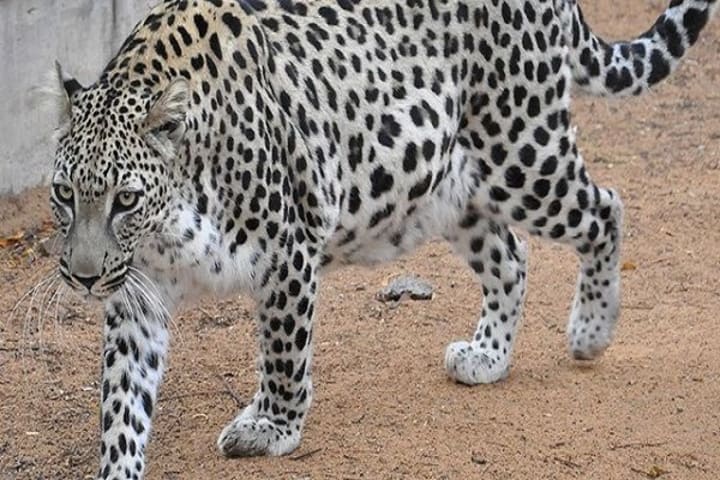
The Arabian leopard (Panthera pardus nimr), also known as the Arabian or Persian leopard, is a critically endangered subspecies of leopard native to the Arabian Peninsula. It is one of the smallest leopard subspecies and is well adapted to its harsh desert and mountainous habitats. Here are the full details about the Arabian leopard:
Physical Description:
Size: Arabian leopards are smaller compared to other leopard subspecies. Adult males typically measure 1.2 to 1.8 meters (3.9 to 5.9 feet) in length, including the tail, which can reach about 0.6 meters (2 feet). Females are slightly smaller.
Weight: Adult males weigh between 30 to 60 kilograms (66 to 132 pounds), while females typically weigh between 20 to 40 kilograms (44 to 88 pounds).
Coat: The Arabian leopard has a tawny or light sandy coat, which provides effective camouflage in its arid habitats. Its fur is shorter and sparser than that of other leopard subspecies.
Habitat:
Range: The Arabian leopard is found in fragmented and isolated populations across the Arabian Peninsula, including Yemen, Oman, Saudi Arabia, and the United Arab Emirates.
Habitat: It inhabits a variety of ecosystems, including mountainous regions, rocky outcrops, escarpments, and arid plains. The species can be found at elevations ranging from sea level to over 2,000 meters (6,500 feet).
Behavior and Adaptations:
Nocturnal: Arabian leopards are primarily nocturnal, being most active during the night and early morning hours. They rest in sheltered areas during the day.
Solitary: These leopards are solitary animals, with males and females coming together only during the mating season.
Territorial: Arabian leopards have large home ranges and mark their territories using scent markings and vocalizations.
Excellent climbers: They are agile climbers, often using trees and rocky ledges for resting, hunting, or surveying their territories.
Prey and hunting: The Arabian leopard's diet mainly consists of ungulates such as Arabian gazelles, Nubian ibex, and Arabian oryx. They are also known to hunt smaller mammals, birds, and reptiles.
Conservation Status and Threats:
Critically Endangered: The Arabian leopard is listed as critically endangered by the International Union for Conservation of Nature (IUCN). The total population is estimated to be less than 250 individuals, with some reports suggesting numbers as low as 50.
Threats: The primary threats to the Arabian leopard include habitat loss, fragmentation, and degradation due to urbanization, infrastructure development, and agriculture. Poaching, conflict with humans, and scarcity of prey species also contribute to their decline.
Conservation Efforts: Various conservation organizations and governments are working to protect and conserve the Arabian leopard. Efforts include establishing protected areas, implementing anti-poaching measures, promoting community-based conservation, and conducting research and monitoring programs.
In conclusion, the Arabian leopard is a critically endangered subspecies of leopard found in the Arabian Peninsula. Its small size, tawny coat, and adaptability to arid environments make it well-suited for survival in harsh desert and mountainous habitats. However, habitat loss, poaching, and a small population size pose significant threats to its survival. Conservation efforts are crucial for the long-term survival of this magnificent and elusive leopard subspecies.
3., Northern Bald Ibis (Geronticus eremita):

The Northern Bald Ibis (Geronticus eremita), also known as the Waldrapp, is a critically endangered bird species that belongs to the ibis family. It is characterized by its unique appearance, including a bald head, long curved bill, and dark plumage. Here are the full details about the Northern Bald Ibis:
Physical Description:
Size: The Northern Bald Ibis is a medium-sized bird, measuring about 70 to 80 centimeters (27 to 31 inches) in length and weighing between 1.5 to 2.5 kilograms (3.3 to 5.5 pounds).
Plumage: The bird has predominantly black feathers with metallic green and purple iridescence. The head and neck lack feathers, revealing bare skin that ranges in color from pinkish to red during breeding season.
Bill: It possesses a long, downward-curving bill that is reddish-orange in color with a black tip.
Habitat:
Range: Historically, the Northern Bald Ibis inhabited a wide range from northern Africa to the Middle East and parts of Europe. However, its range has significantly diminished, and it is now mostly confined to a few isolated populations.
Habitat: The species primarily inhabits arid and semi-arid habitats, including rocky cliffs, canyons, and open steppes. It is also known to frequent coastal areas during the non-breeding season.
Behavior and Adaptations:
Social Behavior: Northern Bald Ibises are highly social birds and form large flocks outside the breeding season. They engage in various social behaviors such as roosting together, foraging in groups, and performing collective courtship displays.
Migratory: The species is known for its long-distance migrations, traveling between its breeding grounds and wintering sites. These migratory journeys can span thousands of kilometers.
Feeding: The Northern Bald Ibis primarily feeds on a variety of invertebrates, including insects, spiders, worms, and mollusks. It forages by probing the ground with its long bill or by searching in shallow water.
Breeding and Reproduction:
Breeding Season: Breeding occurs during the spring and early summer months, typically between March and July.
Nesting: The ibises build their nests on cliff ledges or in trees, using sticks, grass, and other vegetation. The same nesting sites are often used year after year.
Egg-laying and Incubation: The female usually lays 2 to 3 eggs, which are incubated by both parents for about 25 to 30 days.
Parental Care: Both parents participate in raising the chicks, which fledge after about 40 to 50 days. The young ibises remain with their parents for a period before becoming independent.
Conservation Status and Threats:
Critically Endangered: The Northern Bald Ibis is classified as critically endangered by the International Union for Conservation of Nature (IUCN). The global population is estimated to be around 1,000 individuals.
Threats: The main threats to the species include habitat loss, degradation, and fragmentation due to human activities such as agriculture, urbanization, and infrastructure development. Additionally, hunting, disturbance at breeding sites, and power line collisions pose significant threats.
Conservation Efforts: Conservation organizations and governments have implemented various initiatives to protect and conserve the Northern Bald Ibis. These efforts include habitat restoration, captive breeding programs, reintroduction projects, monitoring, and public awareness campaigns.
4., Euphrates Softshell Turtle (Rafetus euphraticus):

The Euphrates Softshell Turtle (Rafetus euphraticus) is a critically endangered species of freshwater turtle belonging to the Trionychidae family. It is known for its unique softshell, which lacks the hard and bony plates found in other turtle species. The Euphrates Softshell Turtle is native to the Euphrates and Tigris river systems in the Middle East. Here are the full details about the Euphrates Softshell Turtle:
Physical Description:
Size: The Euphrates Softshell Turtle is one of the largest freshwater turtle species, with adult individuals measuring 60 to 120 centimeters (24 to 47 inches) in length.
Shell: Its carapace (top shell) is soft and leathery, lacking the typical hard plates found in most turtle species. The shell is usually brown or olive in color, with some individuals exhibiting dark spots or patterns.
Head and Neck: The turtle has a broad head with a long snout and a pair of small eyes. The neck is long and flexible, allowing the turtle to extend its head far from the body.
Habitat:
Range: The Euphrates Softshell Turtle historically inhabited the Euphrates and Tigris river systems, primarily in Iraq and Syria. However, due to habitat loss and degradation, its range has significantly diminished.
Habitat: The species is primarily found in large, slow-moving rivers, including deep pools and backwaters with muddy or sandy bottoms. It requires clean water and ample basking spots.
Behavior and Adaptations:
Aquatic Lifestyle: The Euphrates Softshell Turtle is predominantly aquatic, spending most of its time in the water. Its webbed feet and streamlined shell allow it to swim efficiently.
Basking Behavior: Like other turtles, it engages in basking behavior, where it emerges from the water and rests on rocks, logs, or sandbanks to absorb heat and regulate its body temperature.
Nocturnal Feeding: The species is primarily nocturnal, actively foraging for prey during the night. It feeds on a variety of aquatic invertebrates, fish, amphibians, and occasionally carrion.
Reproduction:
Breeding: The mating season of the Euphrates Softshell Turtle occurs during the spring and early summer months.
Nesting: Females typically dig nest holes in sandy riverbanks or gravel bars, where they deposit a clutch of 10 to 30 eggs.
Incubation: The eggs are left to incubate naturally, relying on the ambient temperature. The incubation period can range from 70 to 110 days.
Hatchlings: Once hatched, the young turtles make their way to the water and begin their independent lives.
Conservation Status and Threats:
Critically Endangered: The Euphrates Softshell Turtle is listed as critically endangered by the International Union for Conservation of Nature (IUCN). It is one of the most endangered turtle species globally.
Threats: The primary threats to the species include habitat degradation, river damming, pollution, illegal hunting for food and the pet trade, and accidental capture in fishing gear.
Conservation Efforts: Conservation organizations and governmental agencies are working to protect and conserve the Euphrates Softshell Turtle. Conservation efforts include habitat restoration, captive breeding programs, monitoring, and public awareness campaigns. The turtle has also received international attention and support for its conservation.
5., Goitered Gazelle (Gazella subgutturosa):
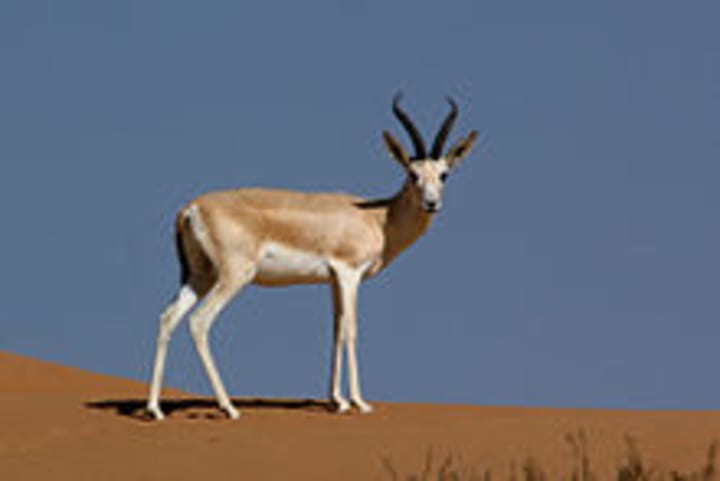
The Goitered Gazelle (Gazella subgutturosa) is a species of gazelle that inhabits the arid and semi-arid regions of Central Asia and the Middle East. It is known for its slender build, long legs, and distinctive white rump patch. Here are the full details about the Goitered Gazelle:
Physical Description:
Size: The Goitered Gazelle is a medium-sized gazelle species. It measures approximately 90 to 140 centimeters (35 to 55 inches) in length and stands about 60 to 90 centimeters (24 to 35 inches) tall at the shoulder.
Weight: Adult males typically weigh between 25 to 45 kilograms (55 to 99 pounds), while females are generally smaller, weighing around 20 to 35 kilograms (44 to 77 pounds).
Coat: The gazelle has a sandy or light brown coat, which blends well with its arid habitat. Its winter coat is thicker and darker than its summer coat.
Habitat:
Range: The Goitered Gazelle has a wide distribution range across Central Asia and the Middle East. It can be found in countries such as Kazakhstan, Uzbekistan, Turkmenistan, Iran, Afghanistan, Iraq, and parts of China and Mongolia.
Habitat: The species primarily inhabits open grasslands, semi-deserts, sandy plains, and foothills. It can adapt to a variety of arid and semi-arid habitats, including steppes and mountainous regions.
Behavior and Adaptations:
Social Behavior: Goitered Gazelles are social animals that live in herds, typically consisting of females, their young, and a dominant male. Males without territories may form bachelor groups.
Nocturnal and Crepuscular: These gazelles are primarily active during the early morning and late afternoon, avoiding the hottest parts of the day. They rest in shaded areas during the day.
Adaptations: The Goitered Gazelle is well adapted to its arid environment. It can withstand high temperatures and has the ability to obtain water from the plants it consumes, allowing it to survive in water-scarce areas.
Diet and Feeding:
Herbivorous: The gazelle is a herbivore, feeding on a variety of vegetation. Its diet includes grasses, herbs, leaves, shoots, and fruits. It has adaptations to digest coarse and fibrous plant material efficiently.
Reproduction:
Breeding Season: The breeding season of the Goitered Gazelle varies depending on the region, but it generally occurs during the spring and summer months.
Mating Rituals: Male gazelles establish territories and engage in displays to attract females. These displays involve various behaviors such as marking the ground with their scent glands, vocalizations, and sparring with other males using their horns.
Gestation and Birth: The gestation period lasts for around six to seven months, after which a single calf is born. The young are capable of standing and walking soon after birth.
Maternal Care: Female gazelles hide their young in vegetation for protection and visit them to nurse. The calves gradually join nursery groups, where they receive additional protection from predators.
Conservation Status and Threats:
Conservation Status: The Goitered Gazelle is listed as vulnerable by the International Union for Conservation of Nature (IUCN).
Threats: The species faces several threats, including habitat loss and fragmentation due to human activities such as agriculture, urbanization, and infrastructure development. Hunting for meat and sport, predation by large carnivores, and competition with livestock for resources also pose threats.
Conservation Efforts: Conservation measures include the establishment of protected areas, habitat restoration projects, monitoring and research programs,
6., Eastern Imperial Eagle (Aquila heliaca):

The Eastern Imperial Eagle (Aquila heliaca) is a majestic bird of prey belonging to the family Accipitridae. It is a large, powerful eagle species found in parts of Eastern Europe, Central Asia, and the Middle East. Here are the full details about the Eastern Imperial Eagle:
Physical Description:
Size: The Eastern Imperial Eagle is one of the largest eagle species. Adult individuals typically measure around 78 to 85 centimeters (31 to 33 inches) in length, with a wingspan ranging from 190 to 220 centimeters (75 to 87 inches).
Weight: Adult eagles weigh between 2.5 to 4.5 kilograms (5.5 to 9.9 pounds). Females are larger and heavier than males.
Plumage: The species exhibits sexual dimorphism in plumage. Adult males have a dark brown body with a golden-brown nape and crown. The shoulder feathers have white patches. Adult females are generally larger and have a lighter brown coloration.
Habitat:
Range: The Eastern Imperial Eagle has a vast distribution range across Eastern Europe, Central Asia, and parts of the Middle East. It can be found in countries such as Hungary, Slovakia, Russia, Kazakhstan, Mongolia, and Iran.
Habitat: The species inhabits a variety of habitats, including open steppes, grasslands, agricultural fields, and woodland edges. It requires a mix of open areas for hunting and nesting sites in tall trees or cliffs.
Behavior and Adaptations:
Diurnal: The Eastern Imperial Eagle is primarily active during the day, utilizing its keen eyesight to spot prey from high perches or during soaring flights.
Strong Flight: It is a powerful flier, capable of soaring at high altitudes and covering large distances during migration or in search of food.
Territorial: These eagles are territorial and defend their nesting areas vigorously. They engage in aerial displays and vocalizations to communicate and establish dominance.
Vocalizations: The species produces a variety of vocalizations, including loud and melodious calls during courtship and territorial displays.
Diet and Feeding:
Carnivorous: The Eastern Imperial Eagle is a carnivorous predator, feeding on a wide range of prey. Its diet primarily consists of small to medium-sized mammals such as rodents, hares, and ground squirrels. It may also prey on birds, reptiles, and occasionally carrion.
Breeding and Reproduction:
Breeding Season: The breeding season of the Eastern Imperial Eagle generally occurs from February to April.
Nesting: The eagles construct large nests made of sticks and twigs in tall trees or on cliffs. They may use the same nest year after year, adding to it annually.
Eggs and Incubation: The female lays 1 to 3 eggs, which are incubated by both parents for about 40 to 45 days. The incubation period begins with the laying of the first egg.
Parental Care: Both parents participate in raising the chicks, providing them with food and protection. The young eagles fledge after about 65 to 75 days and become independent several weeks later.
Conservation Status and Threats:
Conservation Status: The Eastern Imperial Eagle is listed as vulnerable by the International Union for Conservation of Nature (IUCN).
Threats: The species faces various threats, including habitat loss and degradation due to agriculture, deforestation, and infrastructure development. Human disturbance, illegal hunting, electrocution from power lines, and poisoning are additional threats to the eagles.
Conservation Efforts: Conservation measures include the establishment of protected areas, monitoring and research programs, raising awareness about the species, and efforts to mitigate threats such as power line insulation and nest protection
7., Dead Sea Sparrow (Passer moabiticus):

8., Syrian Serin (Serinus syriacus):

The Syrian Serin (Serinus syriacus), also known as the Syrian Yellow Serin, is a small passerine bird species belonging to the finch family, Fringillidae. It is endemic to the Middle East, specifically the region encompassing Syria, Lebanon, Jordan, Israel, and Palestine.
Here are some key details about the Syrian Serin:
Physical Description:
The Syrian Serin measures around 11-12 centimeters in length. The male and female birds have distinct plumage characteristics. The male displays bright yellow feathers on its head, breast, and rump, with black streaks on its back and wings. It has a yellow throat, and its belly is a lighter yellow color. The female has a duller coloration, with more subdued yellow feathers and less prominent black streaks.
Habitat:
This species is primarily found in mountainous regions, particularly in areas with rocky slopes and cliffs. It inhabits scrublands, open woodlands, and sometimes agricultural areas with scattered trees and shrubs. The Syrian Serin is well adapted to arid and semi-arid environments.
Diet:
The Syrian Serin's diet consists mainly of seeds, particularly those of grasses and other herbaceous plants. It forages on the ground and in shrubs, searching for seeds and occasionally consuming small insects.
Breeding and Reproduction:
The breeding season for Syrian Serins typically occurs from March to July. They construct cup-shaped nests using grasses, twigs, and other plant materials, often positioned in low shrubs or trees. The female lays a clutch of 3-6 eggs, which she incubates for about 12-13 days. Both parents participate in feeding the hatchlings until they fledge, which usually takes place around 12-14 days after hatching.
Conservation Status:
The Syrian Serin is listed as a species of least concern on the International Union for Conservation of Nature (IUCN) Red List. While it has a relatively restricted distribution, it is considered common and locally abundant within its range. However, habitat loss and degradation due to urbanization, agriculture, and overgrazing pose potential threats to the species in certain areas.
The Syrian Serin is a delightful and distinctive bird species, known for its bright yellow plumage and melodious song. It contributes to the biodiversity of the Middle Eastern region and serves as an important part of its natural heritage.
9., Euphrates Jerboa (Allactaga euphratica):
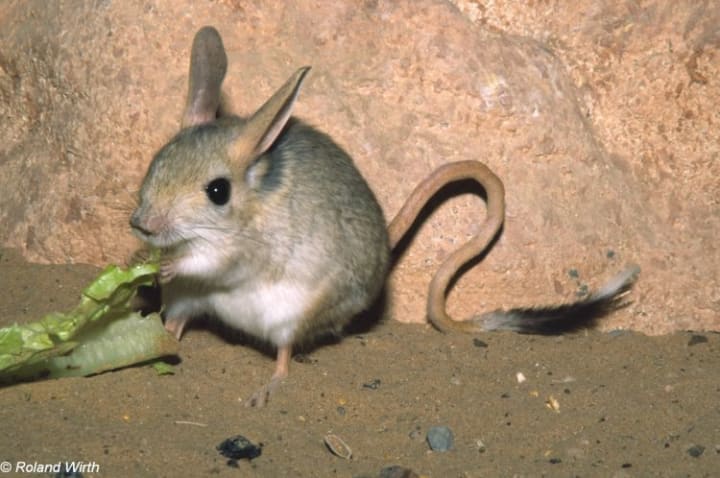
The Euphrates Jerboa (Allactaga euphratica) is a species of small rodent belonging to the family Dipodidae, commonly known as jerboas. It is native to the arid regions of the Middle East, specifically found in countries such as Iraq, Iran, Afghanistan, and Syria. Here are some details about the Euphrates Jerboa:
Physical Description:
The Euphrates Jerboa is a relatively small species, with an average body length ranging from 8 to 11 centimeters, and a tail length of about 12 to 15 centimeters. It has long hind legs that are well-adapted for hopping, similar to kangaroos. The fur of the Euphrates Jerboa varies in color, typically ranging from sandy brown to grayish-brown, helping it blend in with its desert habitat. Its large eyes and ears contribute to its excellent vision and hearing abilities.
Habitat and Behavior:
Euphrates Jerboas are primarily found in arid and sandy environments such as deserts, semideserts, and steppe regions. They are well adapted to desert life and are capable of surviving in extreme temperatures. These nocturnal creatures spend their days in burrows that they dig within the sandy soil, emerging at night to forage for food. Jerboas are known for their remarkable agility and can leap great distances, up to 3 meters, using their strong hind legs.
Diet:
The diet of the Euphrates Jerboa mainly consists of seeds, grains, and plant matter. They are considered herbivorous, feeding on a variety of desert vegetation. They have also been observed to occasionally consume insects and small invertebrates.
Reproduction:
Breeding in Euphrates Jerboas typically occurs between spring and summer. Females give birth to litters of 2 to 6 offspring after a gestation period of around 22 to 30 days. The young are born with their eyes open and are well-developed. They become independent and start venturing out of the burrow after a few weeks.
Conservation Status:
The Euphrates Jerboa is currently listed as a species of least concern on the International Union for Conservation of Nature (IUCN) Red List. Its population is believed to be stable, and it occupies a relatively wide geographic range. However, the species may face localized threats due to habitat degradation, human activities, and desertification.
The Euphrates Jerboa is an intriguing desert-dwelling rodent, uniquely adapted to its arid environment. Its distinctive appearance, fascinating behaviors, and ability to survive in challenging conditions make it an interesting and important part of the ecosystem in its native range.
10., Syrian Wild Ass (Equus hemionus hemippus):
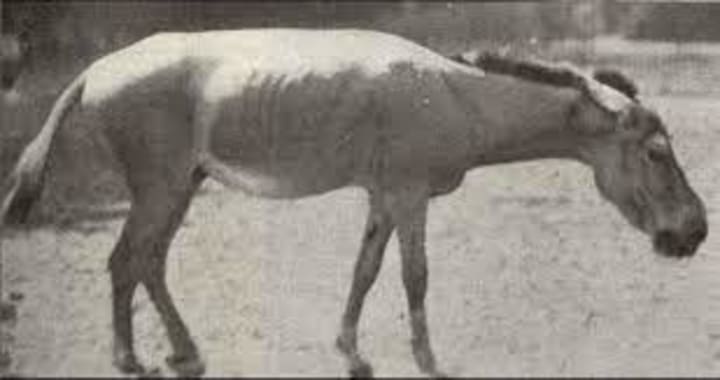
The Syrian Wild Ass (Equus hemionus hemippus), also known as the Syrian Onager or Hemippe, is a subspecies of the Asiatic Wild Ass. It is a critically endangered equid species and is native to the arid regions of Syria, Jordan, and Iraq. Here are some details about the Syrian Wild Ass:
Physical Description:
The Syrian Wild Ass is a medium-sized equid with a distinctive appearance. It has a slender and graceful body, measuring around 2 to 2.3 meters in length and standing about 1.2 to 1.4 meters tall at the shoulder. The coat color varies, but it is typically sandy or reddish-brown, blending well with the desert environment. The species has a dark dorsal stripe running along its back and a whitish belly. The Syrian Wild Ass has long, slender legs and a tufted tail.
Habitat and Behavior:
The Syrian Wild Ass primarily inhabits arid and semi-arid regions, including deserts, steppes, and scrublands. It is well-adapted to survive in harsh desert conditions with limited water and vegetation. The species is known for its endurance and ability to cover long distances in search of food and water. Syrian Wild Asses are primarily herbivorous, feeding on grasses, shrubs, and other desert plants.
Social Structure:
Syrian Wild Asses typically live in small herds consisting of a dominant male, several females, and their offspring. The males engage in territorial behaviors to establish dominance and breeding rights. They communicate through various vocalizations, body postures, and scent marking.
Reproduction:
Breeding in Syrian Wild Asses can occur throughout the year, but it often peaks during certain seasons. After a gestation period of about 11 months, the female gives birth to a single foal. The foal is able to stand and walk shortly after birth and becomes independent within a year.
Conservation Status:
The Syrian Wild Ass is critically endangered according to the International Union for Conservation of Nature (IUCN) Red List. It has faced severe population declines primarily due to habitat loss, hunting, and competition with domestic livestock. Conflict and disturbance in its native range have further contributed to its decline. Conservation efforts are being undertaken to protect and restore the species' habitat, prevent poaching, and establish captive breeding programs to ensure its survival.
The Syrian Wild Ass is a remarkable and rare species, symbolizing the unique biodiversity of the arid regions it inhabits. Efforts to conserve and protect this endangered equid are crucial to preserving its role in the ecosystem and the natural heritage of the region.
About the Creator
Enjoyed the story? Support the Creator.
Subscribe for free to receive all their stories in your feed. You could also pledge your support or give them a one-off tip, letting them know you appreciate their work.


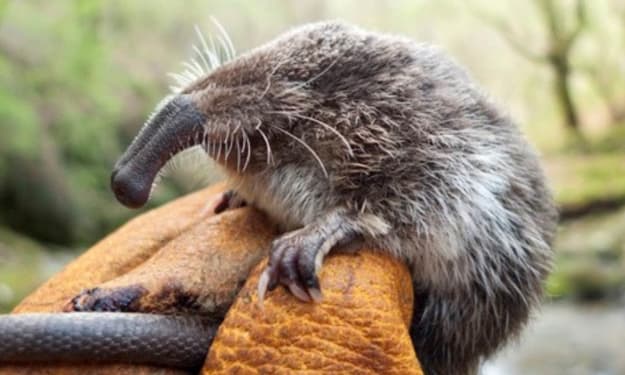



Comments
There are no comments for this story
Be the first to respond and start the conversation.